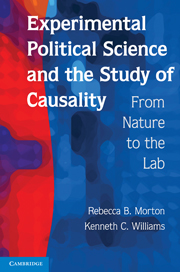Book contents
- Frontmatter
- Contents
- Acknowledgments
- I INTRODUCTION
- II EXPERIMENTAL REASONING ABOUT CAUSALITY
- III WHAT MAKES A GOOD EXPERIMENT?
- IV ETHICS
- 11 History of Codes of Ethics and Human Subjects Research
- 12 Ethical Decision Making and Political Science Experiments
- 13 Deception in Experiments
- V CONCLUSION
- References
- Author Index
- Subject Index
12 - Ethical Decision Making and Political Science Experiments
Published online by Cambridge University Press: 05 June 2012
- Frontmatter
- Contents
- Acknowledgments
- I INTRODUCTION
- II EXPERIMENTAL REASONING ABOUT CAUSALITY
- III WHAT MAKES A GOOD EXPERIMENT?
- IV ETHICS
- 11 History of Codes of Ethics and Human Subjects Research
- 12 Ethical Decision Making and Political Science Experiments
- 13 Deception in Experiments
- V CONCLUSION
- References
- Author Index
- Subject Index
Summary
Expected Benefits and Costs in Experiments
Expectations, Probabilities, and Magnitudes
In Institutional Review Board (IRB) speak, one of the key aspects of determining whether an experiment is ethical is a consideration of the risks to subjects versus the benefits. But as the Office of Human Rights Protections (OHRP) notes in the 1993 IRB Guidebook, the use of the term benefit is inaccurate. It is essentially expected benefits that are considered, not known benefits, because we cannot know for sure what will be learned through the research (otherwise there would be no point to the study). Thus, we are concerned with the product of the two – the probability that benefits can occur times the value of those benefits – or expected benefits. Calculating expected benefits means calculating both the probability of benefit and the value of benefit. Correspondingly, the term risk is confusing as well. The guidebook states at one point that risk is a measure of the probability of harm, not mentioning the magnitude. But certainly the magnitude of harm is as important as the probability (and part of the aforementioned definition of minimal risk). Expected cost (probability of harm times the magnitude of harm) is a more accurate measure to compare to expected benefits. Most IRBs and the OHRP recognize that the comparison between risk and benefit is more accurately thought of as the comparison between the expected costs of the research for the subject (probability and magnitude of harm) and the expected benefits (probability and magnitude of benefits), with risk as shorthand for expected costs and benefits as shorthand for expected benefits.
- Type
- Chapter
- Information
- Experimental Political Science and the Study of CausalityFrom Nature to the Lab, pp. 455 - 499Publisher: Cambridge University PressPrint publication year: 2010



